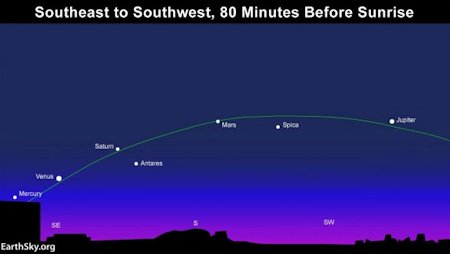Reprinted from the Island Free Press

February evenings begin with Uranus high in the southwest sky. Neptune is closer to the west-southwest horizon. With a visual magnitude of +8, Neptune cannot be seen with the unaided eye. You might be able to spot Uranus — visual magnitude +5.9 — on a very clear night. But most people use a telescope or binoculars.
Supporter Spotlight
The five planets that will be visible to the unaided eye will be in the skies simultaneously for most of February. Jupiter starts the month rising in the East at about 8:30 p.m. Mars will follow at 1 a.m., Saturn at 3:06 a.m., Venus at 5:09 a.m. and Mercury at 5:30 a.m. Astronomical dawn is four minutes later, so all five planets are visible in the sky before daylight begins to make it difficult to view them.
Remember the five planets will not be clustered near the horizon. Venus and Mercury will be very close to the eastern horizon. Saturn will be farther up in the eastern sky. Mars will be just short of overhead. And Jupiter will be in the western part of the sky.
This phenomenon will continue until Feb. 20.
On Friday and Saturday, Feb. 12 and 13, the Hatteras Village Civic Association, with the support of the Outer Banks Visitor Bureau, is having a Starry Nights on Hatteras Island program in the village. The Morehead Planetarium at the University of North Carolina at Chapel Hill will set up a mobile planetarium at the fire station.
The weekend begins at 5:30 p.m. with registration, along with refreshments, at the Hatteras Village Civic Center. The program begins at 7 p.m. The discussion of the night sky over Hatteras with viewing opportunities will be led by Nick Eakes, science education specialist at the Morehead Planetarium.
Supporter Spotlight
On Feb. 13, a mobile planetarium will be set up at the fire station. It looks like a big, domed tent and can fit about 12 to 20 folks inside, depending on how big they are. Once inside, the sky-watchers can get comfy on cushions for the program.
There will be a program for children on Saturday morning at 10:30 a.m. While children take their turn in the planetarium, the others will take part in a program by Rhana Parks of the N.C. Aquarium on Roanoke Island.
Eakes will lead a program for adults in the planetarium at 2 p.m.
At 7 p.m., he will lead another outdoor program on viewing the night skies over Hatteras Island. Depending on wind and weather, the organizers hope to have the program on the beach, at the Sandy Bay parking area north of Hatteras village or in the village park.
Starry Nights will go on rain or (star) shine, but the organizers have their fingers crossed for a couple of those crystal clear nights.
The weekend will end with a special Valentine’s Dance, “Romance Under the Stars,” beginning at 8 p.m. at the Civic Center.
The cost for the Starry Nights program is $20 a person, though the children’s program on Saturday morning is free for the kids. The cost of the dance is $20 a person and $35 per couple.
For information, go to the events page on Facebook. There is information on the page about accommodations and restaurants. You can also message the organizers through Facebook or call 252-986-2109.
Moon Phases
New Moon: Feb. 8
First Quarter: Feb. 15
Full Moon: Feb. 22
Last Quarter: March 1
Astronomy Talk
Astronomical dawn is the time when the geometric center of the sun is at 18 degrees below the horizon. The eastern horizon starts to lighten at the astronomical dawn.
Astronomical dusk is the instant when the geographical center of the sun is at 18 degrees below the horizon. That’s when the sky becomes completely dark.
This story is provided courtesy of the Island Free Press, a digital newspaper covering Hatteras and Ocracoke islands. Coastal Review Online is partnering with the Free Press to provide readers with more environmental and lifestyle stories of interest along our coast. You can read other stories about Hatteras and Ocracoke here.







